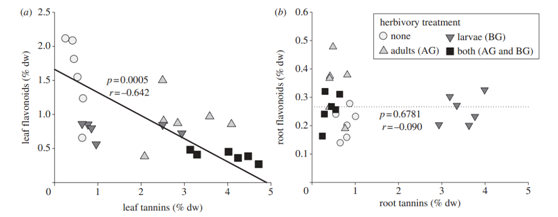Plant Chemicals Mediate the Interaction between Aboveground and Belowground Herbivores
2013-09-10
Plants are consumed by aboveground and belowground herbivores. Damage by aboveground and/or belowground herbivores may affect the levels of primary and secondary chemicals in plants, and changes in these chemicals can mediate the interactions between aboveground and belowground herbivores. To date, however, there is no general framework to illustrate how herbivore-induced changes in plant primary and secondary chemicals impact aboveground and belowground herbivore interactions.
Previously, under the supervision of Prof. DING Jianqing, Dr. HUANG Wei from Key Laboratory of Aquatic Botany and Watershed Ecology, Wuhan Botanical Garden used Triadica sebifera as a study system to examine how plant mediate interactions between aboveground adults and belowground larvae of a specialist flea beetle, Bikasha collaris. Studies showed that aboveground feeding adults increased the performance of belowground feeding conspecific larvae, while larvae negatively impacted adult performance.
In this study, they extended the previous work with the Triadica Bikasha system to investigate the effects of aboveground and belowground herbivory on carbon, nitrogen and secondary chemicals in shoots and roots, and the role of these chemicals in mediating interactions between aboveground and belowground herbivores.
Plants increased root tannins with belowground herbivory, but aboveground herbivory prevented this increase, and larval survival doubled. Aboveground herbivory elevated root nitrogen, probably contributing to increased larval survival. However, plants increased foliar tannins with aboveground herbivory and belowground herbivory amplified this increase, and adult survival decreased. As either foliar or root tannins increased, foliar flavonoids decreased, suggesting a trade-off between these chemicals. Together, these results show that plant chemicals mediate contrasting effects of conspecific larval and adult insects, whereas insects may take advantage of plant responses to facilitate their offspring performance, which may influence population dynamics. These findings help us to better understand how plants evolve with aboveground and belowground herbivores, and how these herbivores interact through plant chemical changes.
Relevant results were published in Proceedings of the Royal Society of London Series B-Biological Sciences (doi: 10.1098/rspb.2013.1318) entitled “Facilitation and inhibition: changes in plant nitrogen and secondary metabolites mediate interactions between aboveground and belowground herbivores”.

The effects of adults (aboveground, AG) and/or larvae (belowground, BG) of a specialist flea beetle Bikasha collaris on total tannins and total flavonoids in (a) leaves and (b) roots of Triadica sebifera. Lines, p-values and r-values are from RMA regressions.